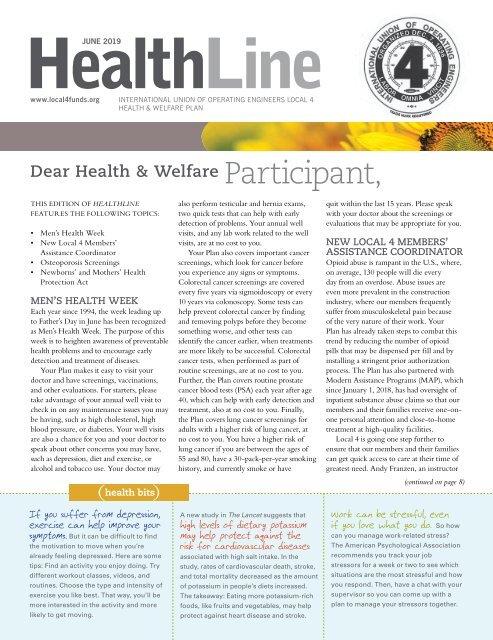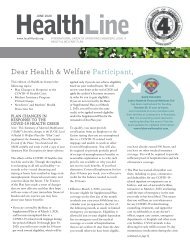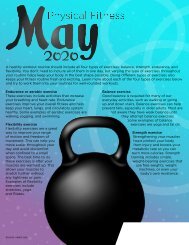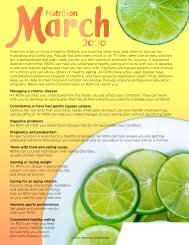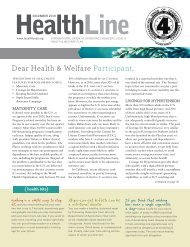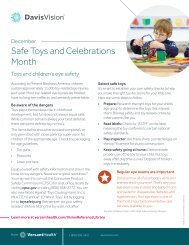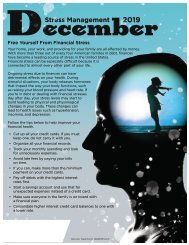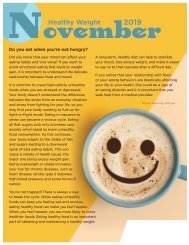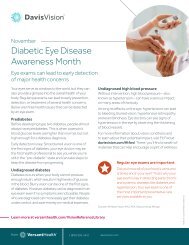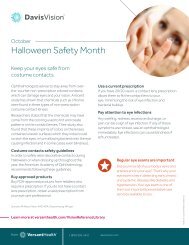Create successful ePaper yourself
Turn your PDF publications into a flip-book with our unique Google optimized e-Paper software.
HealthLine<br />
JUNE <strong>2019</strong><br />
www.local4funds.org<br />
INTERNATIONAL UNION OF OPERATING ENGINEERS LOCAL 4<br />
HEALTH & WELFARE PLAN<br />
Dear Health & Welfare<br />
Participant,<br />
THIS EDITION OF HEALTHLINE<br />
FEATURES THE FOLLOWING TOPICS:<br />
• Men’s Health Week<br />
• New Local 4 Members’<br />
Assistance Coordinator<br />
• Osteoporosis Screenings<br />
• Newborns’ and Mothers’ Health<br />
Protection Act<br />
MEN’S HEALTH WEEK<br />
Each year since 1994, the week leading up<br />
to Father’s Day in <strong>June</strong> has been recognized<br />
as Men’s Health Week. The purpose of this<br />
week is to heighten awareness of preventable<br />
health problems and to encourage early<br />
detection and treatment of diseases.<br />
Your Plan makes it easy to visit your<br />
doctor and have screenings, vaccinations,<br />
and other evaluations. For starters, please<br />
take advantage of your annual well visit to<br />
check in on any maintenance issues you may<br />
be having, such as high cholesterol, high<br />
blood pressure, or diabetes. Your well visits<br />
are also a chance for you and your doctor to<br />
speak about other concerns you may have,<br />
such as depression, diet and exercise, or<br />
alcohol and tobacco use. Your doctor may<br />
If you suffer from depression,<br />
exercise can help improve your<br />
symptoms. But it can be difficult to find<br />
the motivation to move when you’re<br />
already feeling depressed. Here are some<br />
tips: Find an activity you enjoy doing. Try<br />
different workout classes, videos, and<br />
routines. Choose the type and intensity of<br />
exercise you like best. That way, you’ll be<br />
more interested in the activity and more<br />
likely to get moving.<br />
(health bits)<br />
also perform testicular and hernia exams,<br />
two quick tests that can help with early<br />
detection of problems. Your annual well<br />
visits, and any lab work related to the well<br />
visits, are at no cost to you.<br />
Your Plan also covers important cancer<br />
screenings, which look for cancer before<br />
you experience any signs or symptoms.<br />
Colorectal cancer screenings are covered<br />
every five years via sigmoidoscopy or every<br />
10 years via colonoscopy. Some tests can<br />
help prevent colorectal cancer by finding<br />
and removing polyps before they become<br />
something worse, and other tests can<br />
identify the cancer earlier, when treatments<br />
are more likely to be successful. Colorectal<br />
cancer tests, when performed as part of<br />
routine screenings, are at no cost to you.<br />
Further, the Plan covers routine prostate<br />
cancer blood tests (PSA) each year after age<br />
40, which can help with early detection and<br />
treatment, also at no cost to you. Finally,<br />
the Plan covers lung cancer screenings for<br />
adults with a higher risk of lung cancer, at<br />
no cost to you. You have a higher risk of<br />
lung cancer if you are between the ages of<br />
55 and 80, have a 30-pack-per-year smoking<br />
history, and currently smoke or have<br />
A new study in The Lancet suggests that<br />
high levels of dietary potassium<br />
may help protect against the<br />
risk for cardiovascular diseases<br />
associated with high salt intake. In the<br />
study, rates of cardiovascular death, stroke,<br />
and total mortality decreased as the amount<br />
of potassium in people’s diets increased.<br />
The takeaway: Eating more potassium-rich<br />
foods, like fruits and vegetables, may help<br />
protect against heart disease and stroke.<br />
quit within the last 15 years. Please speak<br />
with your doctor about the screenings or<br />
evaluations that may be appropriate for you.<br />
NEW LOCAL 4 MEMBERS’<br />
ASSISTANCE COORDINATOR<br />
Opioid abuse is rampant in the U.S., where,<br />
on average, 130 people will die every<br />
day from an overdose. Abuse issues are<br />
even more prevalent in the construction<br />
industry, where our members frequently<br />
suffer from musculoskeletal pain because<br />
of the very nature of their work. Your<br />
Plan has already taken steps to combat this<br />
trend by reducing the number of opioid<br />
pills that may be dispensed per fill and by<br />
installing a stringent prior authorization<br />
process. The Plan has also partnered with<br />
Modern Assistance Programs (MAP), which<br />
since January 1, 2018, has had oversight of<br />
inpatient substance abuse claims so that our<br />
members and their families receive one-onone<br />
personal attention and close-to-home<br />
treatment at high-quality facilities.<br />
Local 4 is going one step further to<br />
ensure that our members and their families<br />
can get quick access to care at their time of<br />
greatest need. Andy Franzen, an instructor<br />
(continued on page 8)<br />
Work can be stressful, even<br />
if you love what you do. So how<br />
can you manage work-related stress?<br />
The American Psychological Association<br />
recommends you track your job<br />
stressors for a week or two to see which<br />
situations are the most stressful and how<br />
you respond. Then, have a chat with your<br />
supervisor so you can come up with a<br />
plan to manage your stressors together.
2<br />
WHAT’S THE<br />
BUZZ ABOUT<br />
Matcha?<br />
(recipe)<br />
IT’S SAFE TO SAY THAT MATCHA<br />
MADNESS IS TOTALLY A THING RIGHT<br />
NOW. In addition to being widely available<br />
as a beverage, the nutrient-packed green<br />
tea is also popping up as an ingredient in<br />
everything from ice cream to muffins and<br />
more. What exactly is this Kermit-colored<br />
powder, and what’s behind all the hype?<br />
MEET YOUR MATCHA<br />
Matcha is a type of green tea. After the<br />
leaves are harvested, they’re steamed<br />
and ground into a powder. Unlike a<br />
traditional tea bag, you consume the<br />
actual powdered tea leaves.<br />
Matcha contains more caffeine as<br />
well as higher concentrations of the<br />
amino acid L-theanine than other green<br />
teas. The combination of caffeine plus<br />
L-theanine can make you feel alert yet<br />
relaxed at the same time, research shows.<br />
In addition, matcha contains much<br />
higher concentrations of the antioxidant<br />
epigallocatechin gallate compared with<br />
other types of green tea. The compound<br />
may protect against many different<br />
diseases, including cancer, studies show.<br />
GET YOUR FROTH ON<br />
Want to try the tea? Start by getting some<br />
matcha powder in a store or online. Heat<br />
water until just before it boils. In a bowl<br />
or cup, combine about 1 teaspoon of<br />
matcha powder with 6 ounces of the hot<br />
water. Using a matcha whisk or electric<br />
frother, blend together until the matcha<br />
becomes frothy. Then it’s ready to drink!<br />
Baked Chicken<br />
and Cauliflower<br />
Croquettes<br />
2 oz. boneless, skinless chicken breast,<br />
cooked<br />
1 cup frozen cauliflower “rice,” thawed<br />
2 tbsp. minced fresh onion or 1 shallot<br />
1 tsp. white or red wine vinegar<br />
1 tsp. salt-free Italian seasoning<br />
½ tsp. Dijon mustard<br />
¹⁄8 tsp. sea salt<br />
1 egg white, whisked<br />
1 tbsp. plus 1 tsp. chickpea flour<br />
Olive oil spray<br />
1. Preheat oven to 350 degrees. Puree<br />
together chicken breast, cauliflower,<br />
onion, vinegar, Italian seasoning,<br />
mustard, and sea salt in a food<br />
processor fitted with a standard blade.<br />
2. Form mixture into a ball. Squeeze<br />
excess liquid from the ball, then<br />
form 12 1½-inch croquettes.<br />
3. Dip croquettes in egg white. Then roll<br />
croquettes lightly in chickpea flour.<br />
4. Line a cookie sheet with a silicone<br />
baking mat, then spritz with olive oil<br />
spray. Place croquettes on the sheet,<br />
evenly spaced apart, then spritz again<br />
with olive oil spray.<br />
5. Bake for 10 minutes, then gently<br />
flip over to other side. Bake for five<br />
minutes more.<br />
Makes three servings. A serving is four<br />
croquettes. Each serving provides<br />
60 calories, 1 g fat (0 g saturated fat,<br />
0 g trans fat), 20 mg cholesterol,<br />
160 mg sodium, 5 g carbohydrates,<br />
2 g sugar, 1 g fiber, and 9 g protein.
3<br />
ARE YOU OBSESSED WITH<br />
HEALTHY EATING?<br />
MAKING HEALTHY FOOD CHOICES IS<br />
SMART. But can you take healthy eating<br />
too far? If you’re obsessed with eating<br />
only the foods you consider to be healthy,<br />
you may have an eating disorder called<br />
orthorexia.<br />
ORTHOREXIA SIGNS AND SYMPTOMS<br />
People with orthorexia fixate on the<br />
nutritional quality of their food and<br />
obsess about healthy eating to the<br />
point where it actually damages their<br />
well-being. It’s not clear exactly what<br />
contributes to orthorexia. One factor may<br />
be a need to improve self-esteem or regain<br />
a sense of control. Orthorexia is not<br />
officially recognized as a mental disorder.<br />
But awareness about it is on the rise.<br />
Signs you may have orthorexia include:<br />
• Compulsively checking nutrition<br />
labels and ingredient lists<br />
• Cutting out an increasing number<br />
of food groups, such as all sugar,<br />
dairy, or carbs, to the point of harm<br />
• Eating only a small group of foods<br />
on your “healthy” list<br />
• Worrying for hours about food that<br />
will be served at upcoming events<br />
• Feeling very distressed when “healthy”<br />
foods are not available<br />
• Obsessively following food and<br />
healthy lifestyle posts on social media<br />
THE PROBLEM WITH FOOD<br />
RESTRICTION<br />
If you limit the amount and variety of<br />
foods you eat, your body may not get the<br />
vitamins and minerals it needs to<br />
function properly. One of the main<br />
problems associated with orthorexia is<br />
malnutrition. Orthorexia can also cause<br />
many other issues, including:<br />
• Bloating, stomach pain, and<br />
constipation<br />
• Difficulty concentrating and sleeping<br />
• Decreased levels of sex hormones<br />
• Breakdown of muscle tissue<br />
• Dry skin and brittle hair<br />
• Iron deficiency<br />
• Fewer white blood cells for<br />
fighting infections<br />
HELP IS AVAILABLE<br />
If you or someone you love has<br />
orthorexia, it’s important to seek<br />
professional help. Programs for eating<br />
disorders help people overcome<br />
problematic beliefs and learn how to eat<br />
well again. Love and support from family<br />
and friends are also important to recovery.<br />
(health bits)<br />
EATING DISORDERS, SUCH AS ANOREXIA,<br />
BINGE EATING, AND BULIMIA, ARE<br />
SERIOUS, POTENTIALLY LIFE-THREATENING<br />
ILLNESSES—but they can also be treated. Look for<br />
these common signs of an eating disorder: an obsession with body weight or<br />
appearance, going to extremes to limit food intake, or a lack of control over<br />
the amount of food consumed. If any of these symptoms apply to you or<br />
someone you know, consult a medical professional.<br />
GET HELP<br />
Contact the National<br />
Eating Disorders<br />
Association Helpline<br />
at 800-931-2237.
4<br />
PREGNANCY<br />
Discomforts:<br />
WHEN TO CALL THE DOCTOR<br />
BEING PREGNANT CAN BE A WONDERFUL EXPERIENCE, BUT IT MAY ALSO<br />
BRING SOME UNCOMFORTABLE CHANGES TO YOUR BODY. Most of these ills<br />
—including backache, constipation, and morning sickness—aren’t worrisome.<br />
During pregnancy, be sure to watch for signs of the following complications,<br />
which do require medical attention:<br />
1 Ectopic pregnancy: Bleeding and spotting are common and don’t always<br />
mean there’s a problem, but they can be a sign of a serious complication,<br />
including ectopic pregnancy. This occurs when the fertilized egg implants<br />
outside of the uterus—usually in one of the fallopian tubes. In addition to<br />
vaginal bleeding, other signs may include abdominal, pelvic, or shoulder<br />
pain. Because an ectopic pregnancy could endanger your life, tell your<br />
doctor right away if you experience any of these symptoms.<br />
2 Urinary tract infection: It’s normal to urinate more often<br />
while you’re pregnant. However, if you experience pain or a burning<br />
sensation during urination, feel the need to go again right after<br />
urinating, or notice blood in your urine, you may have a urinary tract<br />
infection (UTI). It’s vital to seek treatment for a UTI because it may<br />
lead to a kidney infection—which could trigger early labor.<br />
3 Gestational diabetes: If you’re feeling excessively<br />
thirsty, hungry, or tired, tell your doctor. You may have<br />
gestational diabetes, a type of diabetes that affects only<br />
pregnant women. Left untreated, it can boost the risk<br />
for pre-eclampsia and premature birth. It can also<br />
increase the chance that your baby will be born<br />
with low blood sugar and breathing problems.<br />
4 High blood pressure: Between 6 and<br />
8 percent of U.S. women ages 20 to 44 will<br />
experience high blood pressure during<br />
pregnancy. Gestational hypertension<br />
typically begins after week 20 and<br />
goes away after childbirth. The<br />
condition makes it difficult for the<br />
baby to get enough oxygen and<br />
nutrients and can lead to preterm<br />
delivery and low birth weight. And<br />
pregnant women with high blood<br />
pressure have a higher risk for<br />
pre-eclampsia and placental abruption<br />
(when the placenta separates from the<br />
wall of the uterus).<br />
BANISH BACK PAIN<br />
To relieve back pain during<br />
pregnancy, keep a small pillow at<br />
your lower back for support when<br />
sitting. At night, try sleeping on<br />
your side with a pillow between<br />
your legs or under<br />
your stomach.
5<br />
DON’T GIVE CERVICAL CANCER A CHANCE:<br />
Vaccinate Against HPV<br />
PARENTS NEVER WANT TO SEE THEIR<br />
CHILDREN IN HARM’S WAY. Yet<br />
according to recent data, 51 percent of<br />
adolescents have not received all the<br />
recommended doses of the HPV vaccine.<br />
HPV, or human papillomavirus,<br />
causes almost all cervical cancers.<br />
Learning about the vaccine—and<br />
encouraging your kids to get it—can<br />
reduce their risk for infection and<br />
HPV-related diseases.<br />
VACCINATION LEADS TO<br />
BETTER HEALTH<br />
The HPV vaccine does an excellent<br />
job of vanquishing the virus. Clinical<br />
trials show the shot provides nearly<br />
100 percent protection against<br />
precancers. It also offers a potent<br />
defense against the strain of HPV<br />
that causes genital warts.<br />
What’s more, the side effects from the<br />
vaccine are typically mild and include<br />
arm swelling, fever, and headache. And<br />
because the shot contains only one<br />
protein from the virus, it can’t cause<br />
HPV infections or cancer.<br />
FACTS ABOUT HPV<br />
HPV is spread through sexual contact.<br />
Almost all sexually active people will<br />
eventually catch at least one of the more<br />
than 40 strains if they don’t get the<br />
vaccine. In fact, nearly 80 million<br />
Americans currently have HPV.<br />
Nine out of 10 times, these infections<br />
go away on their own—and many cause<br />
no symptoms at all. Most people never<br />
even know they have HPV. But one in<br />
10 infections will eventually cause<br />
health problems. Besides cervical cancer,<br />
these include:<br />
• Anal, vulvar, vaginal, or penile cancer<br />
• Genital warts<br />
• Cancer in the back of the throat<br />
Every year, cancer caused by HPV affects<br />
about 19,400 women and 12,100 men.<br />
And it’s estimated that one in 100<br />
A SHOT AT GOOD HEALTH<br />
What other vaccines might your preteen need?<br />
Visit www.cdc.gov to find out. Click on “Healthy<br />
Living,” then “Vaccines & Immunizations.”<br />
sexually active adults in the U.S. has<br />
genital warts at any given time.<br />
THE TIME TO ACT IS NOW<br />
Your preteen’s health care provider may<br />
ask you about the shot. You might be<br />
surprised that he or she asks, especially<br />
if you don’t think your child is sexually<br />
active. But the HPV vaccine works best<br />
in people who haven’t yet been exposed<br />
to the virus through sexual contact.<br />
Current recommendations advise that<br />
all boys and girls ages 11 to 12 get two<br />
doses of the HPV vaccine spaced at least<br />
six months apart. But even older teens<br />
and young adults can benefit. Women<br />
can get the vaccine until age 26, and men<br />
through age 21. Some men, such as those<br />
with compromised immune systems, can<br />
catch up on the vaccine through age 26 if<br />
they weren’t vaccinated earlier.
6<br />
Walk This Way:<br />
HOW TO GET STARTED WITH A WALKING PROGRAM<br />
WALKING IS THE IDEAL<br />
WORKOUT FOR MANY<br />
PEOPLE. It’s easy, accessible,<br />
inexpensive, and virtually<br />
injury-free.<br />
Besides helping you lose<br />
or maintain weight, a regular<br />
walking program can help<br />
lower your risk for heart<br />
disease, high blood pressure,<br />
diabetes, high cholesterol,<br />
and osteoporosis. You should<br />
see a health care provider<br />
before you begin walking if<br />
you have a chronic condition<br />
or if you’re older than age 40<br />
and have been inactive. But<br />
you’re ready to start once<br />
you’ve taken that precaution.<br />
GET EQUIPPED<br />
All you need for walking is a<br />
good, supportive pair of shoes.<br />
Walking shoes should be<br />
lightweight and breathable,<br />
with a well-cushioned heel<br />
(where you land as you walk).<br />
When selecting a shoe, test its<br />
flexibility by trying to bend it<br />
with your hands—bendable<br />
shoes help your foot easily roll<br />
forward and push off with the<br />
toes. Also look for good arch<br />
support and nonskid soles. But<br />
the most important thing is<br />
that you wear a shoe that fits.<br />
Tip: Try on shoes with the<br />
socks you plan to wear while<br />
walking.<br />
START EASY<br />
Always do less than you think<br />
you can when you begin; your<br />
muscles and heart need to get<br />
used to the movement.<br />
Initially, try to start out<br />
walking 15 minutes a day. If<br />
that’s more than you can do<br />
right now, do what you can.<br />
Focus on sitting less and<br />
moving more—even a few<br />
minutes of physical activity<br />
is beneficial.<br />
Don’t worry if you last 1<br />
mile or less. It takes time to<br />
build strength and endurance.<br />
GET WITH THE PROGRAM<br />
Need some guidance? Check out<br />
a walking program from the<br />
American Heart Association. Visit<br />
www.empoweredtoserve.org<br />
and search for<br />
“walking program.”<br />
(test your savvy on … family fitness)<br />
1. Children need more exercise than adults. ■ TRUE ■ FALSE<br />
2. For the most benefits, children should participate in organized<br />
sports, and adults should exercise separately in a gym setting.<br />
■ TRUE<br />
■ FALSE<br />
3. Flying a kite, visiting the park, taking the dog for a walk, or<br />
playing tag are family-friendly activities that count toward<br />
your daily exercise goal. ■ TRUE<br />
■ FALSE<br />
4. You should set aside an hour each day just for your family to<br />
exercise. ■ TRUE ■ FALSE<br />
ANSWERS<br />
instead of driving.<br />
and go for a walk after dinner, or bike around the neighborhood<br />
time. Find ways to fit in fitness wherever you can—turn off the TV<br />
4. False. You don’t have to get all your exercise for the day at one<br />
3. True. Fitness can be fun—any activity counts!<br />
make the habit stick.<br />
beneficial. Getting the whole family involved in an activity can help<br />
2. False. Exercise doesn’t have to be traditional or structured to be<br />
each week.<br />
day to stay healthy. Adults should get at least 150 minutes of exercise<br />
1. True. Children need at least 60 minutes of physical activity each
7<br />
5 Ways Busy Parents Can Achieve<br />
BETTER BALANCE<br />
BUSY. HURRIED. OVERWHELMED. If you have kids and those sentiments sound familiar, you’re not<br />
alone—more than 80 percent of parents say they frequently feel rushed. Between jobs, school, homework,<br />
sports, and more, these five tweaks can help you strike a better balance as you try to juggle it all.<br />
1.<br />
MASTER the SLOW COOKER.<br />
Prep your ingredients the night before,<br />
refrigerate them in the removable insert,<br />
plop it into your slow cooker, and hit “start”<br />
in the a.m. A hot meal will be waiting for<br />
you when the day is done.<br />
2.<br />
SEIZE the NIGHT.<br />
Before the morning gets<br />
going, take some time to<br />
prep what you can the night<br />
before, such as laying out<br />
clothes for yourself<br />
and your kids and<br />
packing backpacks.<br />
5.<br />
TACKLE CHORES TOGETHER.<br />
Involve your family in household<br />
responsibilities such as cleaning up<br />
after dinner or tidying the house on<br />
weekends. You’ll knock them out<br />
more quickly and free up time for<br />
other activities.<br />
4.<br />
3.<br />
CREATE<br />
LUNCH LISTS.<br />
Sit down with your<br />
kids and make a list<br />
of different proteins,<br />
grains, fruits, veggies,<br />
and snacks that they<br />
enjoy. Use the list<br />
as your guide to<br />
streamline the lunchpacking<br />
process and<br />
ensure you’re sending<br />
a balanced meal.<br />
LET SOMETHING GO.<br />
You might make it to the grocery store<br />
tonight, but laundry will have to wait until<br />
tomorrow. Maintaining realistic expectations<br />
is key for managing a hectic schedule.
IUOE Local 4 Health & Welfare Plan<br />
PO Box 660<br />
Medway, MA 02053-0660<br />
PRSRT STD<br />
U.S. POSTAGE<br />
PAID<br />
LONG PRAIRIE, MN<br />
PERMIT NO. 372<br />
www.local4funds.org<br />
6272M<br />
(health bits)<br />
It may be tempting to work<br />
off anger or other strong<br />
emotions at the gym, but a study<br />
in the journal Circulation concludes that<br />
it significantly increases your risk for<br />
a heart attack. Looking at more than<br />
12,000 heart attack cases in 52 countries,<br />
researchers found that people who were<br />
angry or emotionally upset in the hour<br />
before they exercised were more than<br />
three times as likely to suffer a heart<br />
attack. Exercise is generally beneficial for<br />
your heart, but make sure you are in a<br />
good emotional place before working out.<br />
Whole grains provide more<br />
fiber than refined ones, but<br />
sometimes it can be difficult<br />
to tell which kind of grain you<br />
are eating. Just because bread is<br />
brown, for example, doesn’t mean it’s<br />
made of whole grains. Molasses or other<br />
ingredients can create the darker color.<br />
Look for foods labeled “whole grain”<br />
and not “cracked wheat,” “multigrain,”<br />
“stone-ground,” “seven-grain,” or “100<br />
percent wheat,” which probably<br />
indicates a refined grain product. Fun<br />
fact: Popcorn is a whole grain. With little<br />
or no butter and salt, it makes for a<br />
healthy whole-grain snack.<br />
A persistent sore and pain in<br />
the mouth are two of the<br />
most common symptoms of oral<br />
cancer. Mouth pain or a sore that<br />
lasts for more than two weeks can be a<br />
sign of many noncancerous conditions<br />
as well. An exam by a health care<br />
professional can help determine the<br />
true cause.<br />
(continued from page 1)<br />
Andy Franzen,<br />
instructor, Local 4<br />
Training Center<br />
at the Local 4 Training<br />
Center and a proud Local<br />
4 member for over 20<br />
years, has been trained<br />
to serve as a conduit between our members<br />
and their families and the higher level of care<br />
that is available at MAP. Andy is a highly<br />
respected member of the Local 4 community,<br />
and he is devoted to serving our members<br />
with the greatest degree of confidentiality<br />
and care. Andy will have Narcan available if<br />
necessary, but our hope is that members and<br />
their families come to Andy before they have<br />
a life-or-death emergency, so that he can<br />
listen, provide support, and steer them in the<br />
right direction before they become one of that<br />
day’s 130 fatalities. Andy has a strong working<br />
relationship with MAP and its great team of<br />
professionals and will work with MAP to<br />
ensure that his brothers and sisters in crisis get<br />
the highest level of care and attention.<br />
Andy can be reached at 781-364-6322 or<br />
by email at afranzen@local4training.org.<br />
OSTEOPOROSIS SCREENINGS<br />
The U.S. Preventive Services Task Force has<br />
revised its recommendations for screening<br />
for osteoporosis. Currently, the Plan covers<br />
routine screening for osteoporosis in women<br />
age 65 and older at no cost share, whereas<br />
women under age 65 must provide a co-pay.<br />
However, as of <strong>June</strong> 1, <strong>2019</strong>, the benefit<br />
has been expanded to include screening<br />
for postmenopausal women under age 65<br />
who are at increased risk of osteoporosis,<br />
also at no cost share. The risk factors for<br />
osteoporosis include parental history of<br />
hip fractures, smoking, excessive alcohol<br />
consumption, and low body weight.<br />
NEWBORNS’ AND MOTHERS’<br />
HEALTH PROTECTION ACT<br />
This act requires group health care plans<br />
to provide a minimum hospital stay for<br />
the mother of a newborn child of 48 hours<br />
after a vaginal delivery and 96 hours after<br />
a cesarean section. Federal law does not,<br />
however, prohibit the mother’s or newborn’s<br />
attending physician, in consultation with<br />
the mother, from determining that a shorter<br />
length of stay is appropriate. The Plan<br />
requires admission certification of your<br />
maternity stay only if the minimum length<br />
of stay (48 or 96 hours, as applicable) is<br />
exceeded. A stay exceeding the minimum<br />
length requires authorization and is subject<br />
to review for medical appropriateness.<br />
Under the Plan, a pregnancy-related hospital<br />
stay is treated like an illness, as required by<br />
federal law.<br />
Sincerely,<br />
Your Board of Trustees<br />
William D. McLaughlin, Chairman<br />
Angelo Colasante<br />
Paul C. DiMinico<br />
David F. Fantini<br />
David Marr, Jr.<br />
James Reger<br />
IUOE Local 4<br />
William D. McLaughlin, Business Manager<br />
Administrator<br />
Gina M. Alongi<br />
Information in the publication is the opinion of the authors. Personal decisions regarding health, finance, exercise, and other matters should be made after<br />
consultation with the reader’s professional advisors. All models used for illustrative purposes only. All editorial rights reserved. Developed by StayWell.


